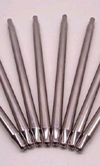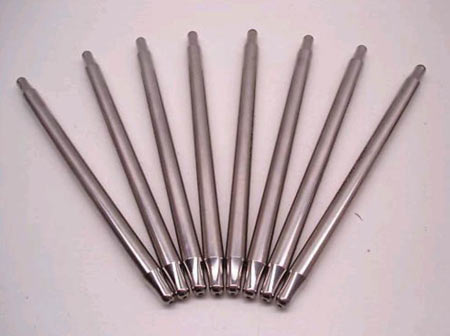Pushrod stiffness
 The pushrod, or overhead valve (OHV), engine has a lot to recommend it in terms of packaging, although it achieves this at the expense of much valvetrain stiffness compared to an overhead cam (OHC) mechanism. One of the least stiff members in the pushrod valvetrain is the pushrod itself. Owing mainly to space constraints, but also possibly to mass targets in a smaller regard, the pushrod is a long slender component whose stiffness can dominate the dynamic behaviour of the whole valvetrain system.
The pushrod, or overhead valve (OHV), engine has a lot to recommend it in terms of packaging, although it achieves this at the expense of much valvetrain stiffness compared to an overhead cam (OHC) mechanism. One of the least stiff members in the pushrod valvetrain is the pushrod itself. Owing mainly to space constraints, but also possibly to mass targets in a smaller regard, the pushrod is a long slender component whose stiffness can dominate the dynamic behaviour of the whole valvetrain system.
For many years, engine designers were, in large proportion, blissfully ignorant of the behaviour of the valvetrain, partly because there was no method by which dynamic valve displacement could be measured, and no easy way to calculate the behaviour of the system. With the advent of both specialised software and test machinery, however, the very thin and flexible pushrods of years past have been supplanted largely by much more substantial items with greater stiffness. In terms of being in proper control of valve motion, these are undoubtedly the correct way to go, but moving in this direction can appear to lose performance initially.
The problem (if it is indeed a problem) is that, in changing to a much stiffer valvetrain, the motion of the valve can be changed substantially. In developing cam profiles to work with the more flexible pushrods, engineers are likely to have developed longer-duration cams, simply to cope with the valve closing earlier than the designed cam lift profile would have suggested. The high acceleration rates at valve closing cause the valvetrain to 'compress', with the pushrod becoming shorter, the arms of the rocker bending slightly and the valve stem also being compressed. The result of this is that the valve seats before we would expect it to, given an infinitely stiff system. The same effect pertains at valve opening, where the opening response of the valve will lag behind the assumed valve lift curve.
Those teams with access to a valvetrain dyno and the ability to measure valve displacement in real time are able to measure this effect. Providing the correct data is entered into suitable calculation software, the same effect is predicted, although simple hand calculations or spreadsheets should be enough to convince the mathematically inclined engineer that the effect on valve timing is both real and substantial.

If you have an engine for which you have developed cam profiles, and you don't have the resources for calculation software or a valvetrain dyno, then you have to take a decision about the benefits of moving to a stiffer pushrod. If you intend to gain more performance through better 'breathing', this will probably mean changes to more 'aggressive' valve lift profiles with higher rates of acceleration, exacerbating the symptoms of insufficient valvetrain stiffness. Changing stiffness at the same time as changing valve lift profile is likely to lead to one effect masking another, so if you have to persevere without analysis or a valvetrain dyno, in changing to a stiffer pushrod you should be prepared to go through the pain of developing your original cam profile to get you back to your starting point in terms of engine performance.
For those with a larger budget and access to analysis and testing, moving to a stiffer pushrod is largely a matter of understanding the implications on the valve lift curve, and the consequent effects on 'breathing' and working around this, while having the benefit of improved valve control.
Fig. 1 - Pushrods such as these, with wide shafts, are becoming popular as valve motion is better understood.
Written by Wayne Ward